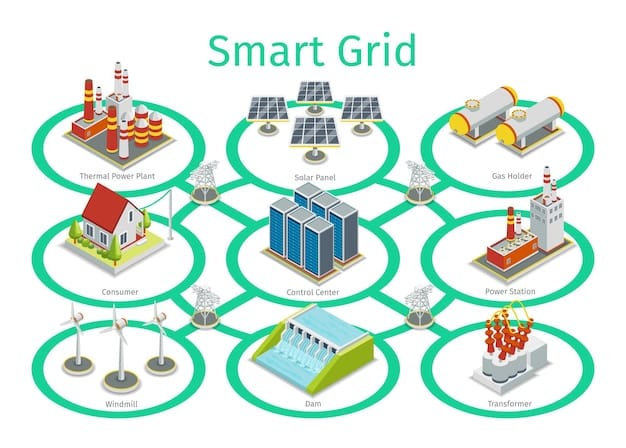US Infrastructure Bill: Key Project Timelines & Completion Dates

The US Infrastructure Bill outlines ambitious project timelines and anticipated completion dates aimed at revitalizing America’s infrastructure across various sectors, signaling a significant multi-year investment in foundational national assets.
The US Infrastructure Bill: What are the Key Project Timelines and Expected Completion Dates? represents a monumental investment in America’s foundational systems, promising widespread upgrades across transportation, utilities, and broadband. Understanding the intricacies of its implementation, including the phased delivery and projected completion of critical projects, is vital for stakeholders, communities, and citizens tracking the nation’s progress.
understanding the infrastructure investment and its scope
The Bipartisan Infrastructure Law (BIL), also known as the Infrastructure Investment and Jobs Act (IIJA), signifies a once-in-a-generation investment. Signed into law in November 2021, it allocates over $1.2 trillion, with $550 billion in new federal spending over ten years, to rebuild America’s roads, bridges, and railways, expand access to clean drinking water, ensure every American has access to high-speed internet, tackle the climate crisis, advance environmental justice, and invest in communities that have too often been left behind. This extensive scope means understanding individual project timelines is complex, as initiatives range from immediate repairs to long-term systemic overhauls.
The law’s implementation is a phased process, starting with the establishment of new programs and funding streams, followed by state and local applications, project approvals, and finally, construction. This multi-year undertaking requires significant coordination among federal agencies, state departments of transportation, local governments, and private sector partners.
federal agencies and their roles
Several key federal agencies are at the forefront of implementing the Infrastructure Bill, each responsible for specific sectors. Their administrative processes and grant cycles significantly influence project timelines.
- Department of Transportation (DOT): Oversees highways, bridges, public transit, rail, aviation, and ports. Many projects here are already underway, with completion dates varying based on scale.
- Environmental Protection Agency (EPA): Manages funding for water infrastructure, including lead pipe replacement and wastewater treatment upgrades. These often involve extensive planning and community engagement.
- Department of Energy (DOE): Focuses on power grid modernization, clean energy initiatives, and electric vehicle charging infrastructure. Projects here may have longer development curves due to technological complexities.
- Department of Commerce (DOC) – NTIA: Leads the charge on broadband expansion, aiming to connect underserved communities. These projects are critical for economic equity and community development.
The initial years of the bill focus on critical repairs and shoring up existing infrastructure, while later phases expand into more transformative projects. This strategic rollout ensures immediate needs are met while also laying the groundwork for future resilience and innovation.
transportation projects: roads, bridges, and transit
Transportation infrastructure receives the largest share of the funding, underscoring its critical role in the nation’s economy and daily life. Projects range from repairing dilapidated bridges to expanding public transit networks and modernizing freight corridors. The timelines for these projects are inherently varied, influenced by factors such as environmental reviews, land acquisition, design complexity, and local permitting processes.
Many states and municipalities have already begun identifying priority projects, with a significant emphasis on “fix-it-first” approaches. This means that instead of solely building new infrastructure, a substantial portion of funds is directed towards maintaining and rehabilitating existing assets to ensure their safety and longevity. This preventive maintenance can often have faster turnaround times compared to new construction projects, though large-scale bridge replacements can still span several years.
highway and bridge rehabilitation
Tens of thousands of miles of roads and thousands of bridges are slated for repair, replacement, or modernization. For smaller-scale repairs, some projects may see completion within 1-3 years of funding allocation. Larger bridge reconstructions, especially those in urban areas or involving complex engineering, could take 5-10 years or even longer. For instance, major interstate bridge projects often involve multiple phases, including preliminary engineering, right-of-way acquisition, and phased construction to minimize traffic disruption.
- Short-term (1-3 years): Pothole repairs, resurfacing state roads, minor bridge deck repairs.
- Medium-term (3-7 years): Significant road widening, interchange improvements, medium-sized bridge rehabilitation.
- Long-term (7+ years): Major interstate reconstruction, complex bridge replacements, new highway segments.
The ability of states to quickly move projects from planning to execution depends heavily on existing project pipelines and administrative capacity. States with shovel-ready projects are often the first to secure funding and commence work, showcasing initial progress and establishing benchmarks for future phases.
public transit, rail, and port upgrades
Beyond roads and bridges, the Infrastructure Bill significantly boosts investments in public transit, passenger and freight rail, and port infrastructure. These sectors are crucial for reducing congestion, facilitating trade, and providing equitable access to transportation.
Public transit projects include expanding existing lines, improving accessibility, and purchasing new, more environmentally friendly buses and railcars. The timelines for these can vary dramatically. Updates to bus fleets may occur within 2-4 years, while new subway or light rail extensions typically take 5-15 years due to extensive planning, land acquisition, and construction challenges. For example, a new metro line often requires tunneling or elevated structures, adding layers of complexity and time.
modernizing rail networks
Amtrak and freight rail networks are set to receive substantial funding for upgrades, safety improvements, and expansion. High-speed rail projects, historically ambitious and time-consuming, are also beneficiaries. While incremental improvements like track upgrades or signal modernizations can be completed within 3-5 years, major new high-speed rail corridors could take 10-20 years to fully develop and become operational. The California High-Speed Rail project, for instance, has been in development for decades, illustrating the inherent challenges.
- Passenger Rail Enhancements: Upgrading existing lines, improving station accessibility, expanding service to new regions. Expected completion for these enhancements range from 3-10 years.
- Freight Rail Capacity: Projects like adding sidings or improving intermodal facilities are often completed within 2-5 years, enhancing supply chain efficiency.
Port upgrades, essential for global trade, involve deepening channels, expanding terminals, and improving freight handling equipment. These projects are usually multi-year endeavors, with significant dredging and construction work potentially spanning 5-10 years, depending on the scale and environmental considerations. The bill seeks to alleviate supply chain bottlenecks, making these upgrades a high priority.

utility infrastructure: water, power, and broadband
The Infrastructure Bill also tackles critical upgrades to America’s most essential utilities: clean drinking water, a resilient power grid, and ubiquitous broadband internet. These infrastructure components are foundational for public health, economic competitiveness, and social equity.
Water infrastructure improvements focus heavily on replacing lead pipes, upgrading wastewater treatment plants, and addressing aging water main systems. The lead pipe replacement initiative alone is a massive undertaking, with an estimated 6 to 10 million lead service lines still in use across the country. While some communities may complete their replacements within 3-5 years, larger cities with more extensive and complex systems could be looking at timelines of 10-15 years or more. These projects involve significant excavation and coordination with homeowners and businesses.
power grid modernization
Investing in the power grid aims for greater resilience against extreme weather events, enhanced cybersecurity, and the integration of more renewable energy sources. Projects here include hardening transmission lines, deploying smart grid technologies, and developing grid-scale energy storage. Many grid modernization projects are anticipated to have timelines of 5-10 years, reflecting the complexity of electrical engineering and the need for coordinated deployment across vast areas.
- Lead Pipe Replacement: Small communities 3-5 years; large cities 10-15+ years.
- Wastewater Treatment Upgrades: 5-10 years, depending on the scale of technology adoption.
- Grid Resiliency & Microgrids: 5-8 years for significant overhauls and new deployments.
The challenge lies not just in the engineering but also in navigating varied state regulations and utility company structures. Ensuring a coordinated effort across diverse stakeholders is key to meeting projected timelines.
broadband expansion and digital equity
One of the most ambitious goals of the Infrastructure Bill is to ensure every American has access to affordable, reliable high-speed internet. This initiative directly addresses the digital divide, particularly in rural and underserved urban areas. Broadband infrastructure rollout is a significant undertaking, requiring extensive fiber optic cable deployment and the establishment of new wireless facilities.
The timeline for achieving universal broadband access is projected to be within 5-8 years, although many initial connectivity projects are expected to be deployed much sooner. The initial phase focuses on connecting unserved and underserved locations. States are currently developing their “Broadband Equity, Access, and Deployment” (BEAD) plans, which will guide where and how funding is allocated. These plans take time to develop and approve, but once in motion, construction can move relatively quickly, though terrain challenges in remote areas can prolong deployment.
state-level implementation challenges
States play a pivotal role in the broadband rollout, responsible for identifying eligible areas, awarding grants to providers, and overseeing project execution. This decentralized approach allows for flexibility but also introduces variability in timelines.
- Planning & Allocation: 1-2 years for states to finalize plans and award initial grants.
- Deployment in Rural Areas: 3-5 years for significant build-out in challenging terrains.
- Urban & Suburban Gaps: 2-4 years for connecting remaining unserved pockets.
Full completion of broadband coverage across the entire US within the bill’s ten-year framework is an aggressive but achievable goal, provided there is sustained political will, efficient administrative processes, and robust collaboration among all levels of government and the private sector. The emphasis is not just on infrastructure, but on digital equity, ensuring that all Americans can participate in the modern economy and society.

resilience, climate change, and environmental justice
The Infrastructure Bill also allocates substantial funds towards making communities more resilient to climate change impacts, investing in clean energy, and addressing historical environmental injustices. These projects often involve innovative solutions and community-specific approaches, with varied timelines.
Resilience measures include hardening infrastructure against extreme weather (e.g., elevated roads, stronger sea walls), investing in natural infrastructure solutions (e.g., wetlands restoration for flood protection), and improving power grid resilience. Many of these projects are integrated into broader infrastructure upgrades, with timelines mirroring those of the primary assets they protect. For instance, designing a new bridge to be climate-resilient is part of its overall 5-10 year construction timeline.
advancing clean energy initiatives
Clean energy investments encompass a range of projects, from developing electric vehicle (EV) charging networks to supporting advanced nuclear reactors and carbon capture technologies. The nationwide EV charging network is a priority, with initial goal of 500,000 chargers by 2030, a project likely to see substantial deployment within 3-7 years, with continuous expansion thereafter.
- Coastal Resilience Projects: Often 5-10+ years due to complex environmental permitting and large-scale engineering.
- EV Charging Infrastructure: Initial build-out 3-7 years; ongoing expansion beyond that.
- Legacy Pollution Cleanup: Timelines for Superfund and brownfield sites can span 5-20 years, depending on the severity and complexity of contamination.
Environmental justice initiatives prioritize cleanup of legacy pollution sites in disadvantaged communities and ensuring equitable access to clean water and healthy environments. These projects can be particularly complex and long-term, requiring extensive community engagement and remediation efforts, with some lasting beyond the 10-year scope of the bill as they tackle decades of neglect.
challenges and future outlook for infrastructure projects
While the Infrastructure Bill presents a transformative opportunity, its successful execution is not without significant challenges. These include inflationary pressures, labor shortages, supply chain disruptions, and the sheer scale of coordination required across federal, state, and local entities. Each of these factors can impact project timelines and completion dates.
Inflationary costs for materials like steel, concrete, and asphalt can stretch project budgets, potentially leading to delays or scope reductions unless additional funding is secured. The demand for skilled labor in construction, engineering, and related fields is high, and attracting and retaining workers will be crucial for keeping projects on schedule. Supply chain issues, exacerbated by global events, can delay the delivery of critical components, from microchips for smart infrastructure to specialized machinery.
overcoming implementation hurdles
Federal agencies and states are implementing strategies to mitigate these challenges, such as streamlining permitting processes, investing in workforce development programs, and leveraging domestic supply chains. The emphasis on project bundling, where multiple smaller projects are combined, can also create efficiencies and attract larger contractors, potentially accelerating delivery.
- Ongoing Monitoring: Continuous oversight by federal and state entities to track progress and address bottlenecks.
- Adaptive Planning: Flexibility in project plans to respond to unforeseen market conditions or environmental factors.
- Workforce Development: Programs focused on training and retaining skilled workers for infrastructure jobs.
Despite these hurdles, the long-term outlook for the US Infrastructure Bill remains largely positive. The consistent flow of dedicated funding over the next decade provides stability for long-term planning and execution. As projects move from planning to construction, the initial focus on “shovel-ready” initiatives will pave the way for more complex, transformative endeavors, ultimately enhancing America’s competitiveness, improving public safety, and fostering a more sustainable future. Public and private partnerships will continue to be a vital component in driving these projects forward efficiently and effectively.
| Key Project Area | Typical Timelines & Scope |
|---|---|
| 🛣️ Roads & Bridges | Minor repairs: 1-3 years; Major replacements: 5-10+ years. Focus on rehabilitation and new construction. |
| 🚂 Transit & Rail | Fleet upgrades: 2-4 years; New lines: 5-15 years. Enhancing capacity and safety. |
| 💧 Water Infrastructure | Lead pipe replacement: 3-15 years; Treatment plant upgrades: 5-10 years. Prioritizing clean water access. |
| 📡 Broadband Access | Rural build-out: 3-5 years; Universal access goal: 5-8 years. Connecting underserved communities. |
Frequently asked questions about the infrastructure bill
The Bipartisan Infrastructure Law allocates funding over a period of ten years, from fiscal year 2022 through fiscal year 2031. This long-term commitment aims to provide stability and consistent investment for transformative infrastructure projects across the nation, allowing for multi-year planning and phased execution to maximize impact and efficiency.
Project timelines are determined by various factors, including project complexity, environmental review processes, land acquisition requirements, design and engineering phases, and local permitting. The scale of the project, from minor repairs to large-scale new construction, also plays a significant role in projecting its duration. Federal agencies and state/local governments work together to set realistic completion goals.
While the funding is allocated over ten years, many large-scale, complex projects may have completion dates that extend beyond this initial period. The bill provides the initial capital and framework, but some extensive undertakings, such as major high-speed rail lines or comprehensive grid overhauls, might require longer development and construction phases that could span more than a decade.
Key challenges include inflationary costs for materials and labor, workforce shortages, and supply chain disruptions. Additionally, the complexities of inter-agency coordination, local regulatory hurdles, and unforeseen environmental or geological issues can contribute to delays, potentially extending initial timeline projections for many critical infrastructure developments.
Several government websites, including Build.gov and agency-specific portals, provide updates on funded projects and their progress. States also often maintain their own dashboards and announcements regarding local infrastructure initiatives. Public awareness and civic engagement can help ensure transparency and accountability throughout the implementation of these vital projects, enabling citizens to monitor developments.
Conclusion
The US Infrastructure Bill, with its substantial funding and broad scope, sets the stage for a decade of transformative projects aimed at modernizing America’s foundational systems. While individual project timelines vary significantly based on complexity, scale, and location, the phased implementation strategy seeks to ensure both immediate impact and long-term systemic improvements. From repaved roads and rebuilt bridges to universal broadband access and a resilient power grid, the initiatives are designed to enhance national competitiveness and improve the quality of life for all Americans. Despite the inherent challenges of such massive undertakings, the commitment to sustained investment provides a clear pathway for progress, with many key projects expected to reach completion within the upcoming years, while others lay the groundwork for a more robust and sustainable future stretching beyond the initial funding window. Continued oversight and adaptability will be crucial to successfully navigate the complexities of this ambitious infrastructure revitalization effort.





